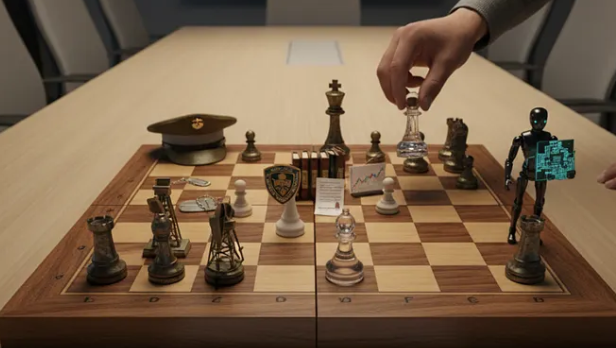My Career Isn’t a Ladder, It’s a Chessboard

Why my unconventional resume isn’t a sign of indecision, but my greatest strategic asset.
Lay my resume on a table, and I know what you’ll see. It doesn’t look like a ladder. There’s no steady, predictable climb up a single corporate structure.
Instead, you see a collection of seemingly disconnected worlds. A U.S. Marine Corps Officer. A Regulatory Representative in the oil and gas industry. A Market Strategist at a major university. And now, the founder of an AI development company.
The pattern-matching part of our brain immediately flags it. The classic red flag for a recruiter: the “job-hopper.” It’s a resume that, on the surface, lacks a clear, linear narrative.
But the most effective strategies rarely unfold in a straight line. The ladder is a fine metaphor if your goal is simply to climb. My goal has always been different. I haven’t been climbing a ladder; I’ve been building out a chessboard.
Each move wasn’t a hop; it was a strategic repositioning. It was a deliberate choice to acquire a new, distinct piece for the board — a new capability from a completely different battlefield — in preparation for a much more complex game down the road.
I didn’t “hop” from these industries. I harvested them.
Harvesting the Battlefield: Leadership Under Pressure
In the Marine Corps, I wasn’t learning to code. I was learning about leadership when the stakes are absolute. The most crucial lesson was the concept of “Commander’s Intent.” You don’t give your team a rigid, step-by-step plan that will inevitably break upon first contact with reality. Instead, you give them the mission’s ultimate goal — the why. You equip them with the purpose, and you trust them to make smart, independent decisions to achieve it.
Today, that’s how I run tech projects. I don’t just assign tickets; I ensure every engineer understands the business problem we are solving. That is how you build a team that is resilient, autonomous, and capable of navigating the chaos of a real-world product launch.
Harvesting the Corporate World: Navigating Complexity
In the oil and gas industry, I wasn’t fine-tuning LLMs. I was getting a masterclass in navigating one of the most complex regulatory landscapes on the planet. I learned how to manage multi-million dollar projects where a single compliance error could have catastrophic consequences. I learned to translate dense, technical regulations into actionable strategies for teams on the ground.
Today, when I architect an AI system, that discipline is ingrained in my process. I am constantly thinking about data privacy, ethical guardrails, and the long-term consequences of the technology I’m building. It’s the voice that asks not just “Can we build this?” but “Should we build this, and how do we do so responsibly?”
Harvesting the Market: Understanding the End-User
At Texas A&M’s Division of Marketing, I wasn’t writing Python scripts. I was in a deep-dive immersion into the mind of the end-user. My job was to understand market dynamics, identify pain points, and communicate the value of a complex institution to a diverse audience. I learned that the most brilliant product in the world is useless if it doesn’t solve a real human problem and if its value can’t be communicated clearly.
Today, that experience is the first filter for every project I take on. Before I write a line of code, I am relentlessly focused on the user. Who are we building this for? What problem are we solving for them? This user-centric approach is what separates a cool tech demo from a viable, valuable product.
The Strategist’s Mosaic
A career path that looks like a straight line can be a sign of focus, and that has its own strengths.
But a path that looks like a chessboard is the sign of a strategist. It’s the sign of someone who understands that the most complex problems are never solved with a single tool.
They require a mosaic of skills — leadership, discipline, empathy, and technical expertise — all working in concert.
My journey has allowed me to collect the pieces:
The Rook of disciplined execution from the military.
The Bishop of navigating complex, diagonal problems from the corporate world.
The Queen of understanding the entire board from a marketing and strategy perspective.
Now, as a founder and developer, I’m not just playing one piece. I’m playing the whole board.
So when you see a resume that isn’t a straight line, I urge you to look closer. It may not be a sign of someone who is lost. It may be the sign of someone who has been deliberately building, piece by piece, the exact combination of skills needed for the complex game ahead.
Don’t hire for the ladder they’ve climbed. Hire for the board they can see.